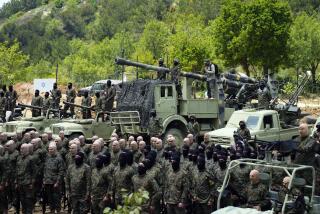Inspectors visit 11 chemical weapons sites in Syria
BEIRUT — Inspectors have visited almost half of Syria’s declared chemical weapons sites as part of an ambitious plan to destroy the nation’s lethal stockpiles, an international watchdog agency said Wednesday.
A team of experts in Syria has now “concluded verification activities” at 11 sites, the Organization for the Prohibition of Chemical Weapons said in a statement. All “were well within government-held territory,” said Michael Luhan, a spokesman for the Hague-based agency overseeing the undertaking.
Inspectors were unable to visit one other site because of security issues, Luhan said.
“We weren’t able to get sufficient guarantees to send our team in,” Luhan said in a telephone interview. “The battle lines shift quite frequently.... It’s a fluid situation.”
The OPCW’s director general, Ahmet Uzumcu, has said that temporary cease-fires may be required to inspect some of the more than 20 sites identified by Syrian officials as chemical weapons facilities. Such inspections would require guarantees of safety from both government and opposition groups.
Syrian officials have said publicly that as many as seven chemical sites may be in areas where antigovernment rebels are active.
The joint United Nations-OPCW team is undertaking the unprecedented task of trying to eliminate a nation’s chemical arsenal amid a war.
Inspectors face a number of tight deadlines, including a Nov. 1 target for rendering Syria’s chemical weapons facilities inoperable. Under the U.N.-approved timetable, all of Syria’s chemical weapons, are to be destroyed by mid-2014.
The accelerated schedule arose from a U.S.-Russian accord that averted U.S. airstrikes in retaliation for a series of poison gas attacks on rebel-held areas outside Damascus, the Syrian capital, on Aug. 21.
The Syrian government denied any role in the attacks and blamed opposition forces. But Syria agreed to the elimination of its chemical arsenal and joined a global treaty outlawing the use, production and stockpiling of such weapons.
Inspectors in Syria have already destroyed some equipment and weaponry, including missile warheads, bombs and mixing and filling machinery, the OPCW has said. Basic tools such as sledge-hammers, chain saws and bulldozers may be used in the initial phase of work, experts say.
The more complex destruction of Syria’s chemical stockpiles, estimated at 1,000 tons, is to come later.
The Syrian government submitted an initial disclosure of its chemical weapons facilities. But Damascus has until Oct. 27 to present a “more detailed and structured” declaration, said Luhan, the OPCW spokesman. Syria’s cooperation has thus far been “excellent,” he said.
The United Nations-OPCW team in Syria is made up of about 60 experts and is expected to expand to 100, officials say.
Also on Wednesday, U.N. Secretary-General Ban Ki-moon announced the appointment of Sigrid Kaag, a veteran U.N. official and former Dutch diplomat, as special coordinator for the U.N.-OPCW mission in Syria.
“We have no illusions over the challenges ahead,” Ban said in a statement. “The situation in Syria remains dangerous and unpredictable. The cooperation of all parties in Syria is required.”
Last week, the OPCW was awarded the Nobel Peace Prize for its work in helping to rid the globe of chemical weapons.
ALSO:
Six-party talks with Iran adjourn, leaving no clues to progress
The worst good news possible: Mexico gets World Cup lift from U.S.
With money at risk, China is restrained about a possible U.S. default
Twitter: @mcdneville
More to Read
Sign up for Essential California
The most important California stories and recommendations in your inbox every morning.
You may occasionally receive promotional content from the Los Angeles Times.








